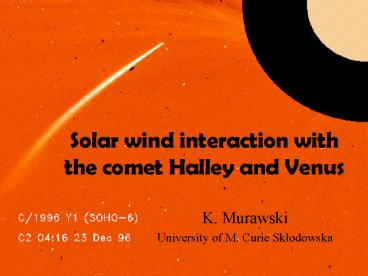Solar wind interaction with the comet Halley and Venus - PowerPoint PPT Presentation
1 / 44
Title:
Solar wind interaction with the comet Halley and Venus
Description:
Solar wind interaction with the comet Halley and Venus K. Murawski University of M. Curie Sk odowska * One type is left, namely the SW interaction with an ... – PowerPoint PPT presentation
Number of Views:106
Avg rating:3.0/5.0
Title: Solar wind interaction with the comet Halley and Venus
1
Solar wind interaction with the comet Halley and
Venus
- K. Murawski
- University of M. Curie Sklodowska
2
Outline
- Overview of solar wind interaction with
- magnetic and non-magnetic bodies
- Numerical simulations of the solar wind
- interaction with Venus
- Numerical simulations of the solar wind
- interaction with the comet Halley
- Summary
3
A global view of the Heliosphere
4
Solar system - Icy Matter ...
Jan Oorts Cometary Cloud
5
Outskirts of the Solar system - Comets
6
Properties of the solar wind
- highly conducting plasma
- electrons, protons alpha-particles
- radial expansion
- magnetic field frozen in the plasma
- SW super-sonic super-alfvénic
- ne 5 cm-3
- T 105 K
- BIMF 5 nT
- vsw 400 km/s
- vA 30 - 50 km/s
- cS 60 km/s
7
TYPES OF INTERACTION WITH THE SOLAR WIND
GANIMEDE
8
Simplest caseEarth's MOONNO magnetic fieldNO
atmosphere
9
MOON type
- no magnetic field
- negligibly thin atmosphere
- insulating material
- submerged in a flowing plasma
- absorption of particles
- no bow shock upstream
- plasma absorption wake
- magnetic field parallel to the upstream flow ? no
effect - magnetic field perpendicular to the flow ?
minimal effect
Illustration of the interplanetary plasma flow
and magnetic-field perturbation by the
nonconducting moon. The wake created by
solar-wind absorption closes more quickly when
the magnetic field is not aligned with the
undisturbed flow.
10
SW interactions with magnetized bodiesand an
atmosphere
Obstacle magnetosphere
11
EARTH type (Jupiter, Saturn)
- strong magnetic field
- substantial atmosphere
12
SW interactions with magnetized bodiesbut
without an atmosphere
Obstacle magnetosphere
13
MERCURY - type
- strong magnetic field
- no gravitationally bound atmosphere
- Similarities and differences with Earth
- Magnetosphere
- Absence of an atmosphere and ionosphere
- Solar wind conditions
- Mercury has a larger fractional volume of its
magnetosphere - no stable trapping regions
- closed magnetic flux tubes
- Solar wind primary source of magnetospheric
plasma - Plasma sheet higher densities
0.382 AU Mercury
14
COMETSNO internal magnetic fieldbut atmosphere
Obstacle exosphere
15
What is Solar Wind?
- COMETS
16
Comet Structure
- Nucleus main solid core of the comet.
- Tail gas and dust particles released by the
comet. - Coma gases and dust released by the comet when
energy from the sun heats the comet and causes
the solid materials to turn into a gas.
17
Comet Tails
- Comets develop tails only when the get close
enough to the Sun. - Comet tails always point away from the SunThis
is how scientists first realized the existence of
solar wind.
18
Comet type
- no internal magnetic field
- substantial atmosphere
19
- Numerical model - MHD
20
- Numerical results
21
- Numerical results
22
- Numerical results
23
- Numerical results
24
- Numerical results
25
- Numerical results
26
SW interactions with unmagnetized bodies with a
substantial atmosphere
Obstacle ionosphere
27
Venus
28
VENUS type
- weak magnetic field or non at all
- substantial atmosphere
29
Structure of the Ionosphere
Brace and Kliore, 1991
30
Location of the obstacle boundary
31
Induced magnetotail
32
Pick up and escape processes
Escape
Energetic neutral atoms (ENAs)
Escape
33
Ionospheric magnetic field
34
(No Transcript)
35
Altitude (Km)
Number Density (cm-3)
36
Numerical model - Draping magnetic field lines
Solar wind
37
Physical model 2 component MHD
38
Parameters of the physical model
39
Pressure distribution
Interaction region
IMF
bow shock
magnetic barrier
ionosphere
40
Pressure profiles in the subsolar region
X
41
Plasma profiles
X
42
Magnetic field lines and nightside ionosphere
Z
XZ plane
Solar wind
X
IMF
Y
XY plane
43
Concluding remarks
- Flowing plasma interactions with various types of
- magnetized planets or
- unmagnetized / weakly magnetized bodies
- Each plasma interaction has distinctive features
- Earth magnetic field and atmosphere
- Mercury magnetic field but NO atmosphere
- Moon like bodies neither a magnetic field nor
an atmosphere - Venus and Mars no internal magnetic field but
a substantial atmosphere - Comets atmospheres with insignificant bodies
44
Thank you!
kmur_at_kft.umcs.lublin.pl































